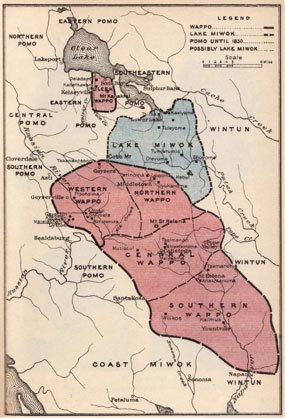
The Original People
It is now believed that people first came to the North American continent some 24,000 years ago, and that they arrived here in the Valley of the Moon some time after that— perhaps 12,000 years or more ago.
Who they were is not certain either, but it is known that our region became in time the most densely populated place in the entire continent, and that many languages were spoken by widely diverse groups of people. Their landscape was likewise diverse, from the ocean on the west to the mountains and valleys to the east, and from the forests of the north to the wetlands of the south. It was a generous land as well, providing plentiful food for the gathering and a comfortable climate that required very little in the way of clothing or shelter.
The people who were here when the European colonists arrived in the 19th Century— just two hundred years ago— have been named for certain characteristics and the languages that they spoke. To the northeast were the Wappo— originally called by the Spanish guapo or brave, for their courageous struggle to survive. To the northwest were the Pomo— their own name for the red earth of their original village farther north. To the south were the Miwok— a word that simply means “the people” in their own language.
Although the boundaries of these peoples shifted over the centuries, they met and traded here with one another fairly frequently. Life was easy enough to allow a culture closely identified with the land and rich in celebration, reverence, and creativity to flourish. With colonization came the loss of their lands and the decimation of their population through disease and genocide; however, contemporary Native communities survived and are now revitalizing many of their cultural and religious practices.
The Wappo
As long ago as 6,000 years, and probably longer, the Wappo (a branch of the Yukian language family) emerged from the proto-Yukian group occupying the Mayacamas range along the eastern edge of our valley. Their name derives from the Spanish term “guapo” or brave, for their stubborn resistance to becoming subdued by Mexican colonists.
Anthropologists have noted that -sonoma appears as a suffix in several common Wappo village names. It is believed the name for Sonoma indicates they once occupied our entire valley, and began moving back towards the headwaters of Sonoma Creek in the Mayacamas mountains as the Miwok arrived from the southwest, perhaps some 3,000 years ago..
The Pomo
The Pomo group of people (a branch of the Hokan language family) ranged southward from beyond Clear Lake as far as the Santa Rosa plain, reaching into our valley from the northwest. Their name refers to the red earth of the region near the present-day community of Pomo, in Mendocino County. They are known to this day as masters of basket weaving and jewelry making.
Before contact with Europeans in the early 19th Century, the Pomo lived in hundreds of small independent communities, speaking several different languages but linked by geography and marriage. They relied upon fishing, hunting, and harvesting native plants for their daily food supply, and were a somewhat nomadic people who gathered in small groups. The Bitakomtara Pomo may have been actually two separate groups, with one located at the headwaters of Santa Rosa Creek in the Mayacamas range and the other in Santa Rosa.
The Miwok
The word Miwok means “people” in their native language (a branch of the Penutian language family). Like the Wappo and the Pomo they lived in small bands, without a centralized political authority. They were hunter-gatherers and fishers, eating meals according to appetite and enjoying a leisurely life.
The Miwok enjoyed organized athletic games, had domestic dogs as pets, and cultivated tobacco. These were the people that met with Sir Francis Drake for several days in 1579, when he claimed California for England. Chaplain Fletcher, who was with that expedition, wrote: “They are of a free and loving nature, without guile or treachery.”



